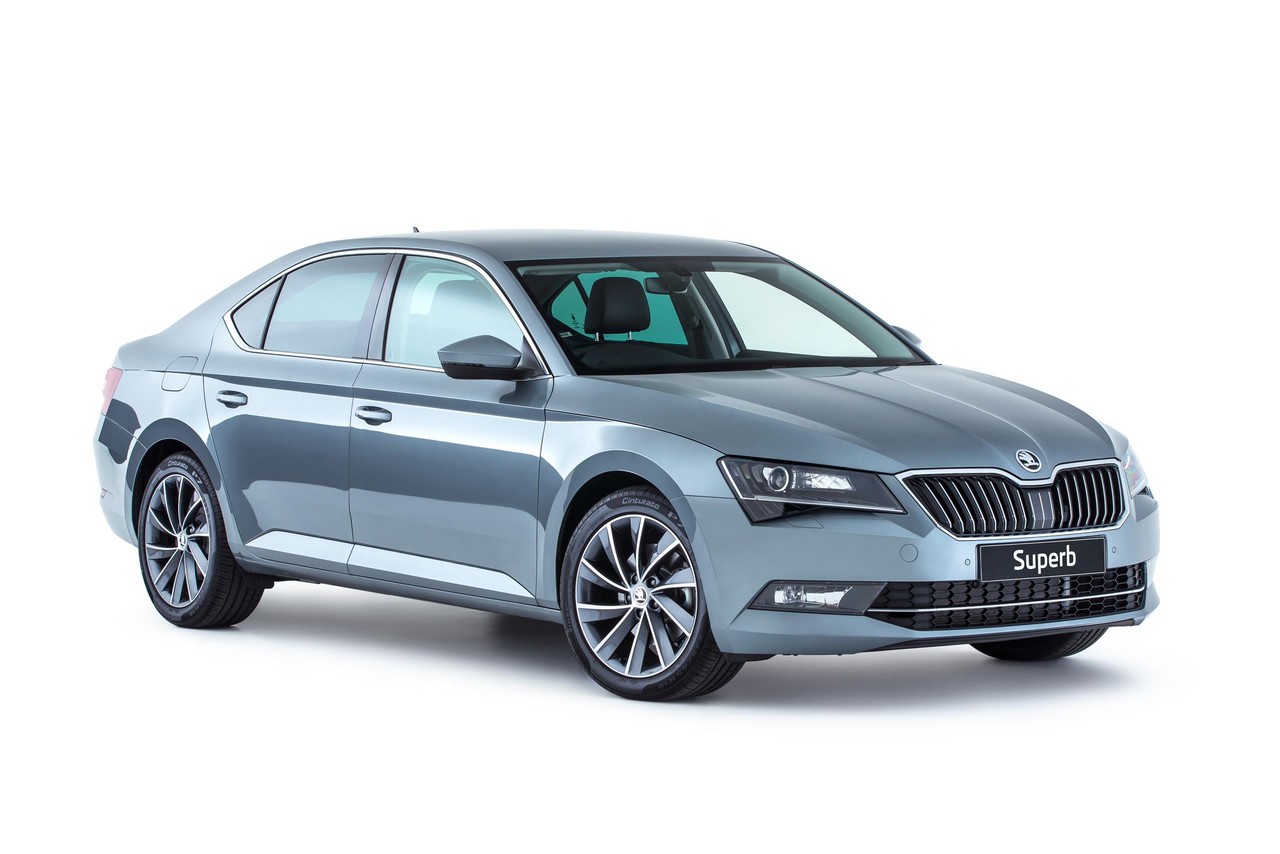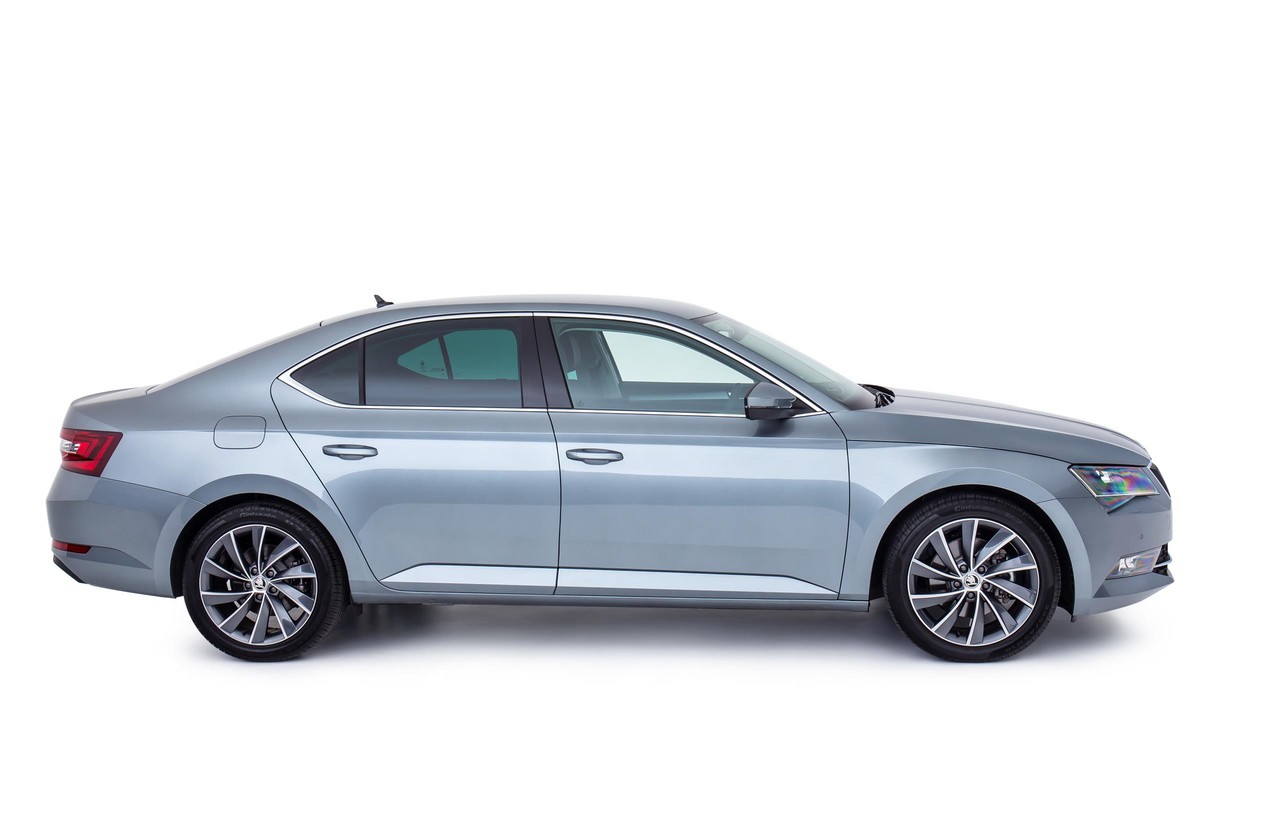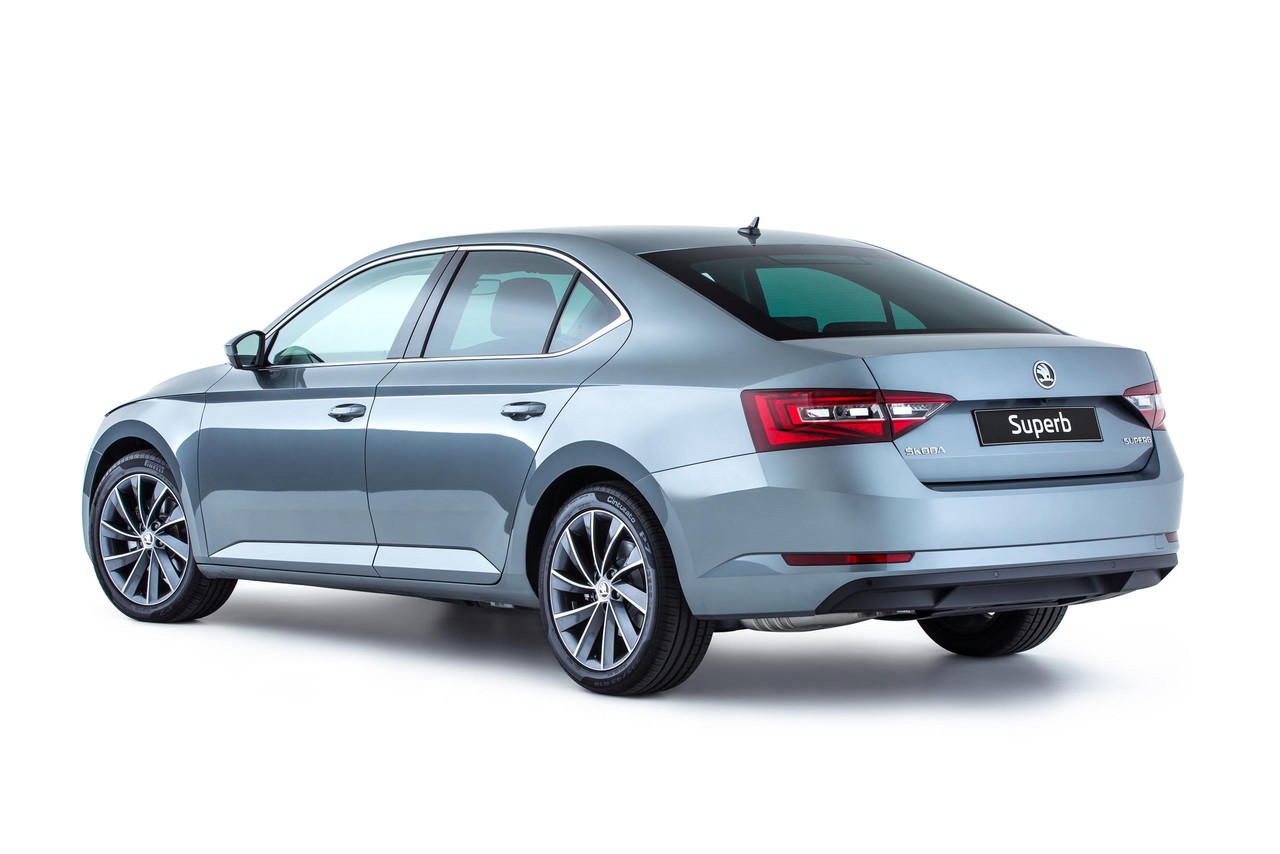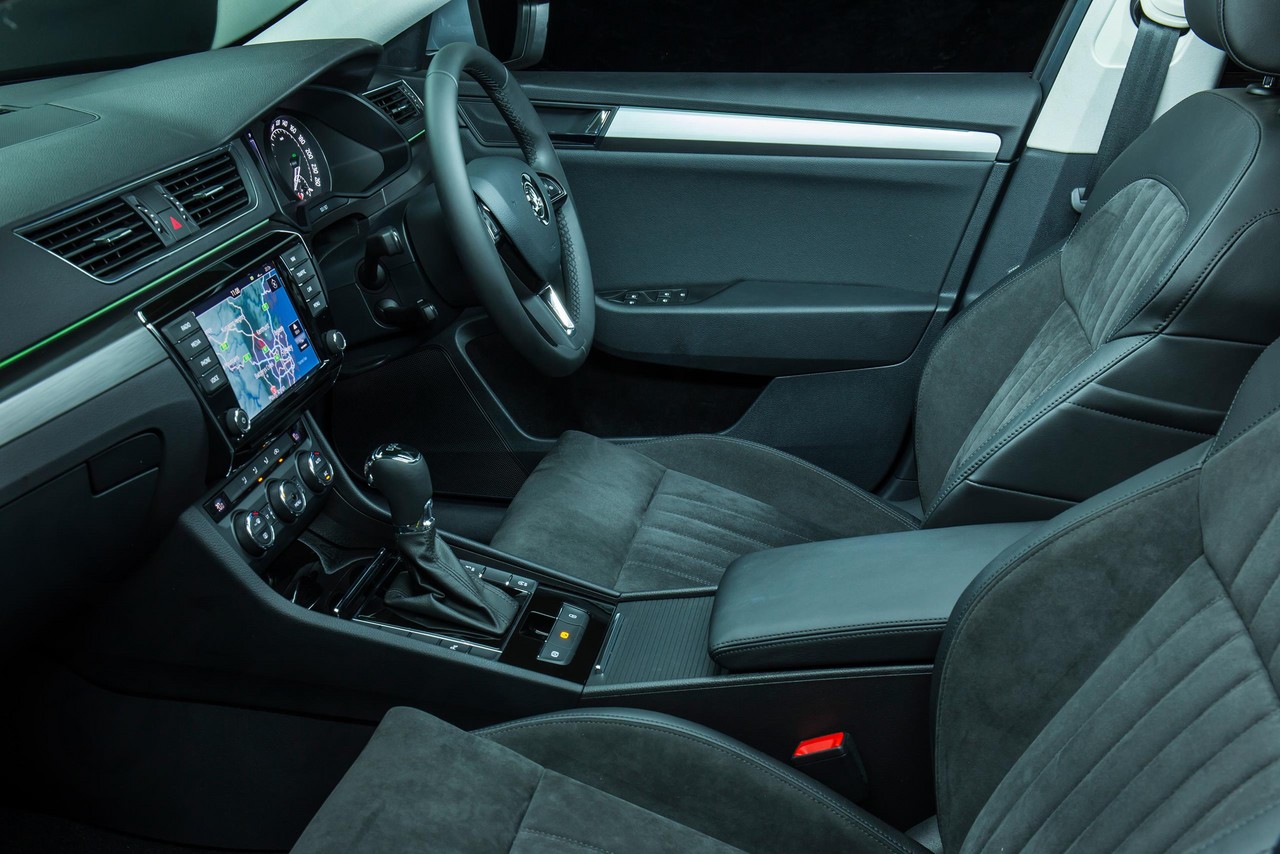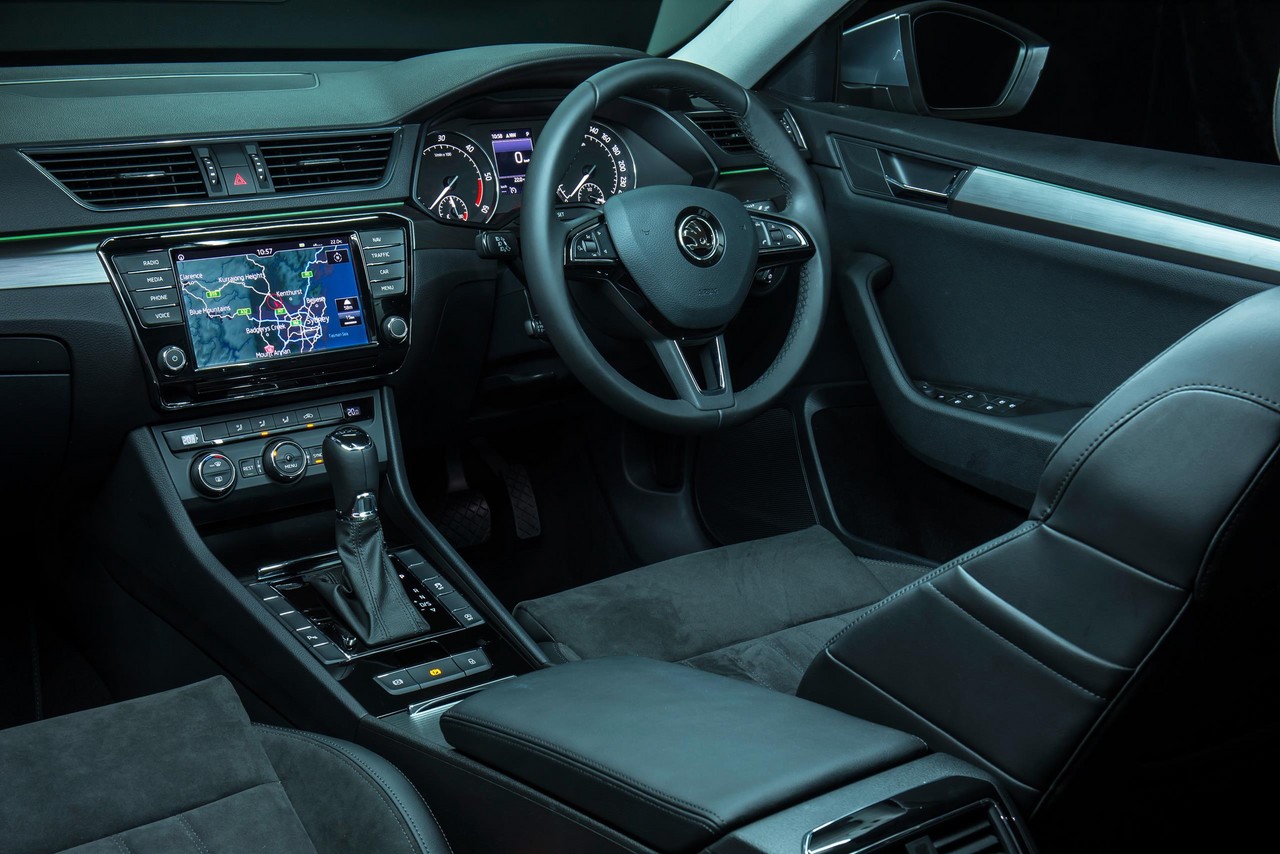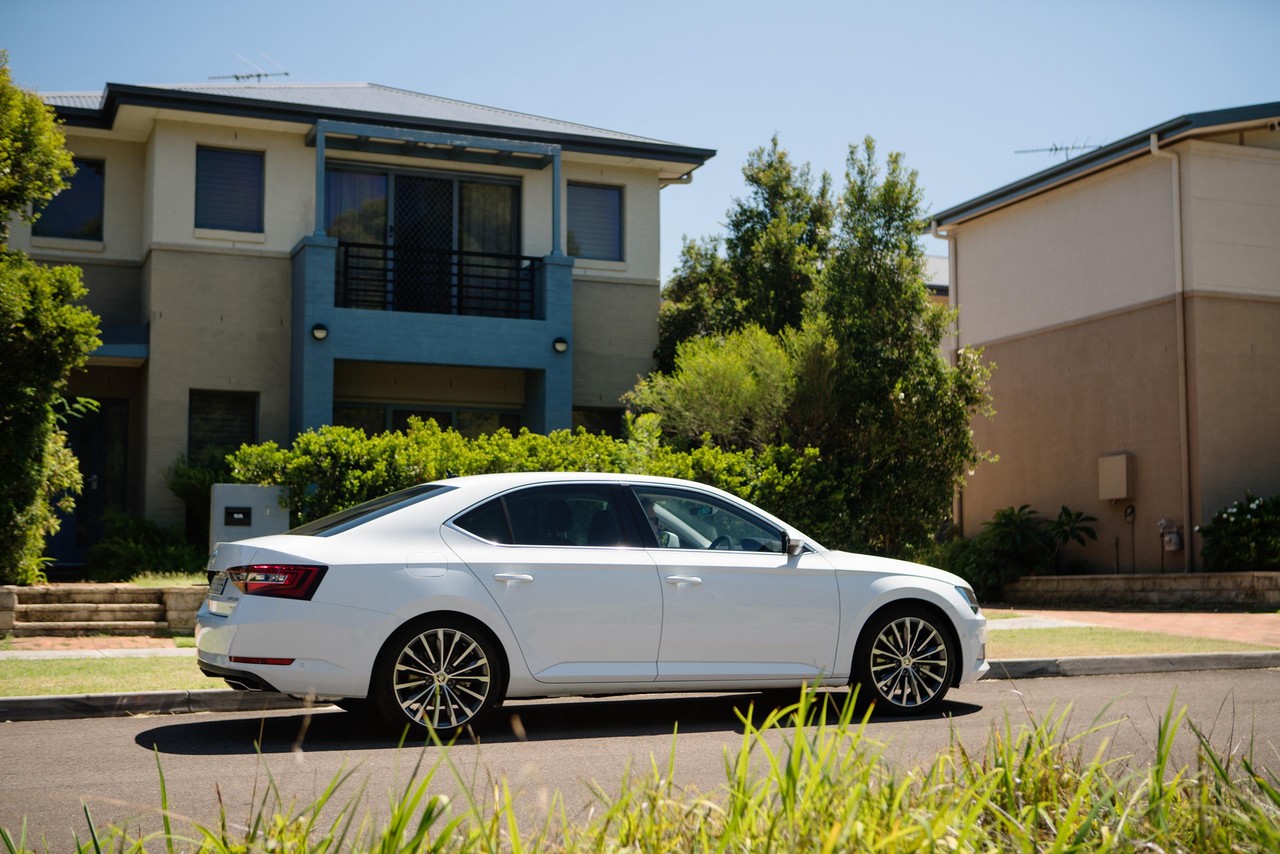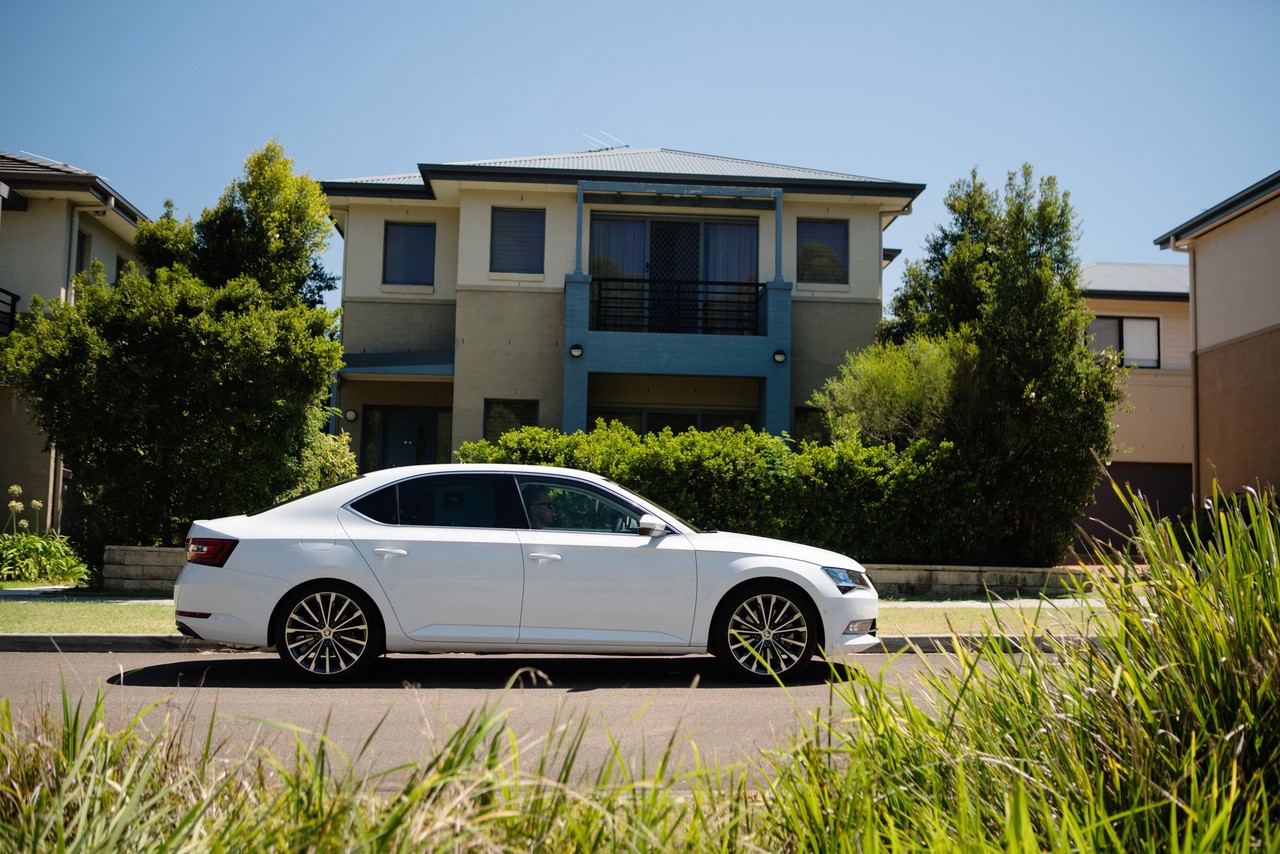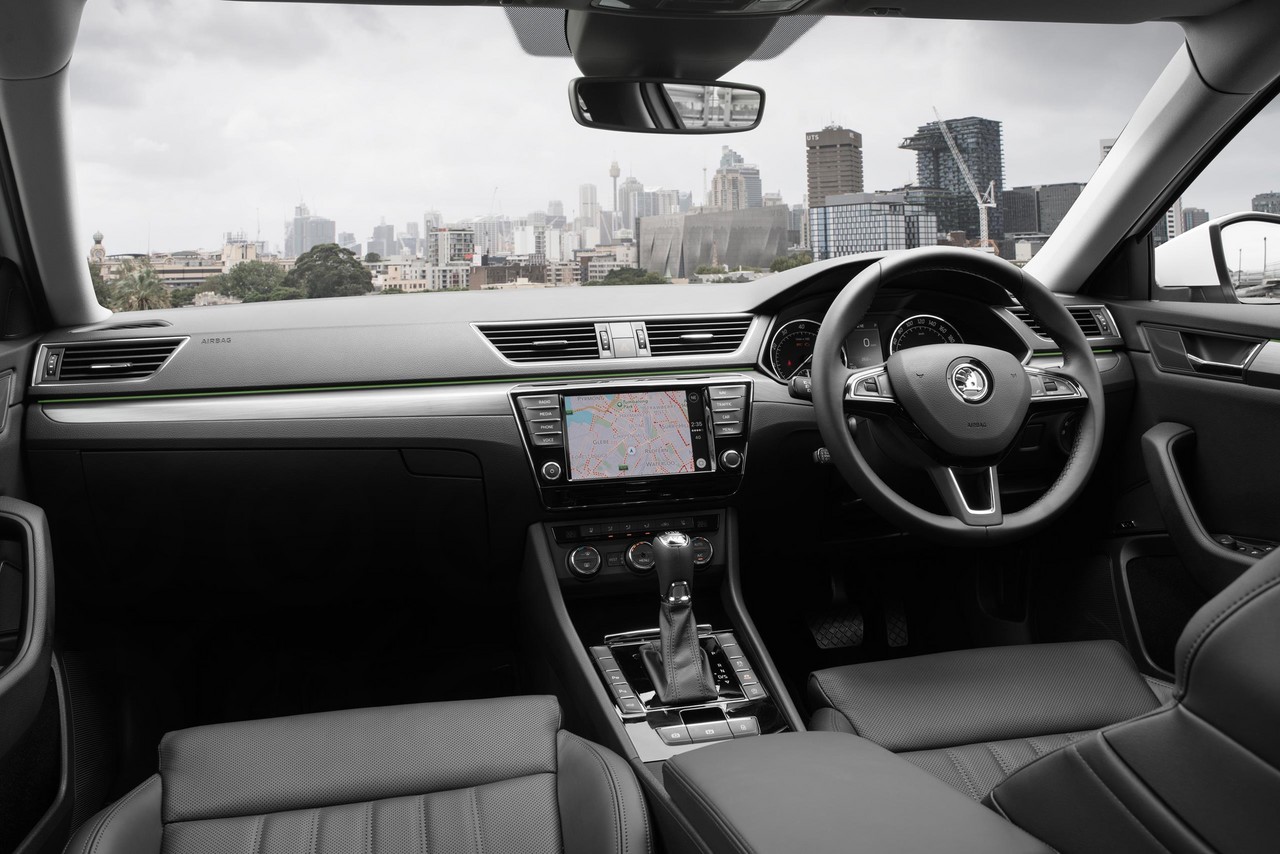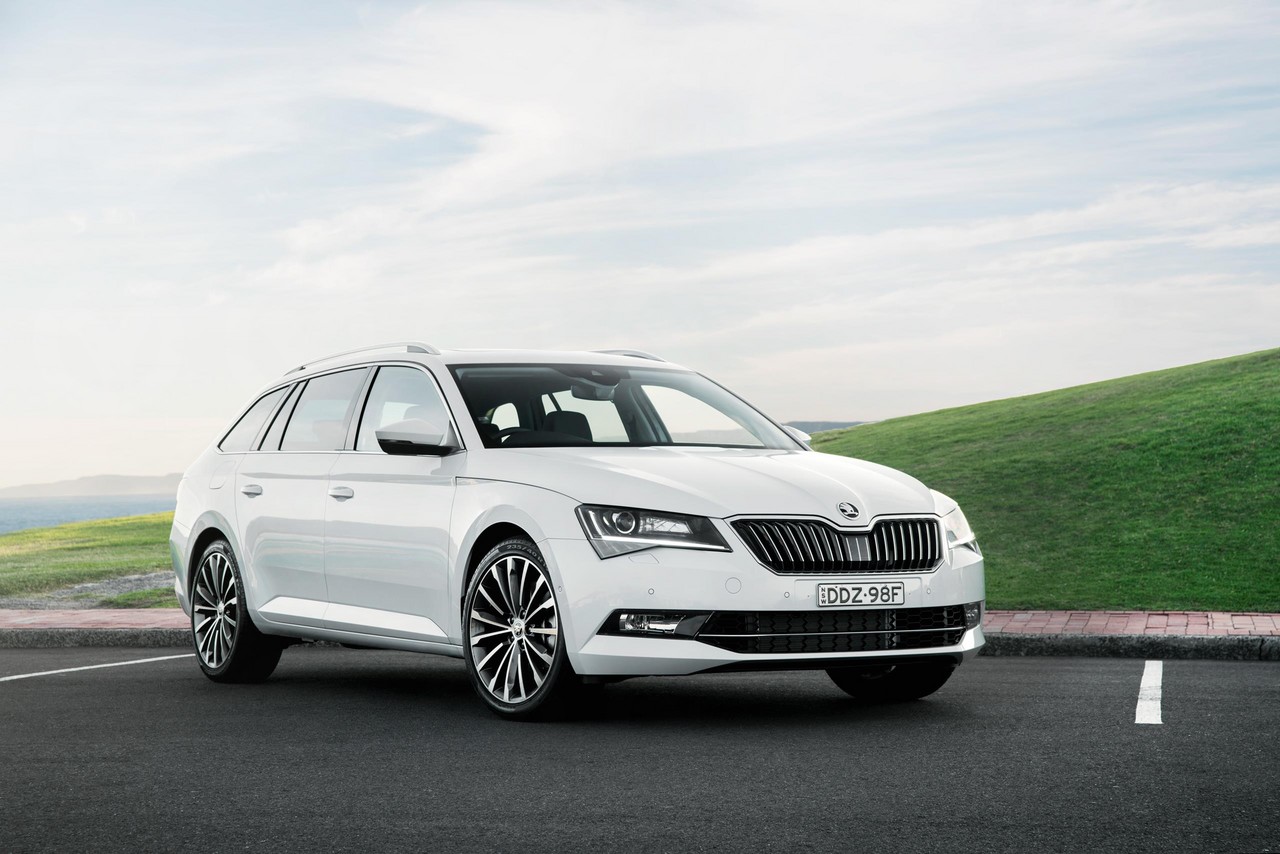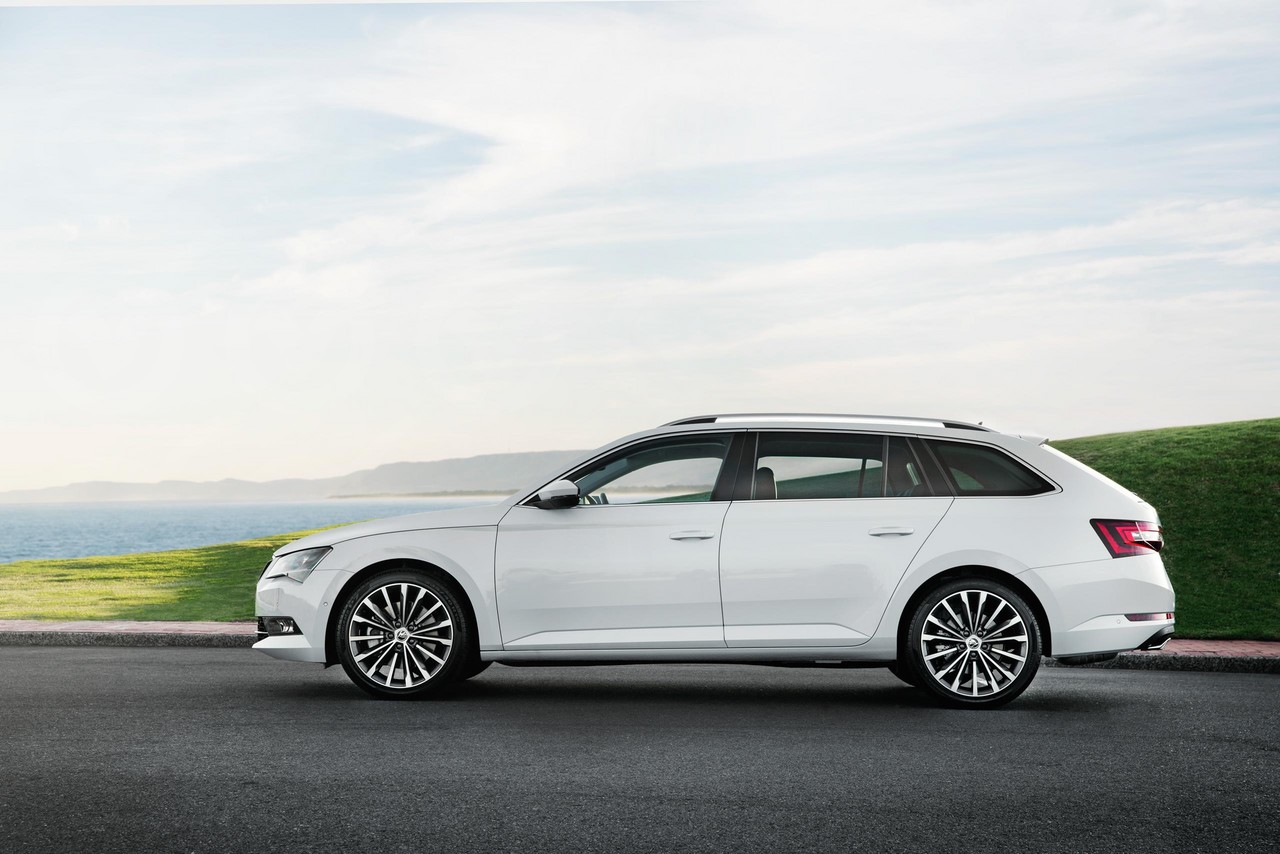
- Quite and spacious interior (particularly rear legroom)
- High standard of interior fit and finish
- Five star safety rating and AEB as standard
- Suspension is tuned for comfort…
- … but is under-damped (i.e. continues oscillating after initial rebound)
- Uncomfortable centre rear seat
- For 2.0-litre turbo diesel engine, some turbo lag below 1600 rpm
- Depending on driving position, thick A-pillars may impair visibility
- No storage space for cargo cover once removed
Overview
Commencing production in March 2015 and officially released in Australia in March 2016, the Skoda NP Superb was available as a large sedan or wagon. Manufactured in Kvasiny, Czech Republic, the Skoda NP Superb range consisted of front-wheel drive 140TDI and 162TSI and all-wheel drive 206TSI variants, all of which had six-speed double clutch transmissions (‘DSG’).
All engines complied with Euro 6 emissions standards and had:
- A ‘Stop-Start’ function which enabled them to shut down when the vehicle was stationary in traffic; and,
- ‘Brake energy recovery’ which increased alternator output when the vehicle was braking or coasting to more rapidly charge the battery.
Of these engines, the Superb 162TSI was powered by Volkswagen Group’s CHHB engine which was shared with the Volkswagen Mk.7 Golf GTi , while the Superb 206TSI was powered by the CJXA engine which was closely related to the CJXB engine which powered the Volkswagen Mk.7 Golf R .
| Engine | Trans. | Peak power | Peak torque | |
|---|---|---|---|---|
| 140TDI | 2.0-litre DDA turbo-diesel I4 | 6sp DSG | 140 kW at 3500-4000 rpm | 400 Nm at 1750-3250 rpm |
| 162TSI | 2.0-litre CHHB turbo petrol I4 | 6sp DSG | 162 kW at 4500-6200 rpm | 350 Nm at 1500-4400 rpm |
| 206TSI AWD | 2.0-litre CJXA turbo petrol I4 | 6sp DSG | 206 kW at 5600-6200 rpm | 350 Nm at 1700-5600 rpm |
Haldex 5 all-wheel drive (AWD) system
The Skoda Superb 206TSI had a fifth-generation Haldex all-wheel drive system which consisted of an electronically controlled and hydraulically actuated multi-plate clutch that was located in front of the rear axle differential (at the end of the prop shaft). Under low loads or when coasting, the rear axle was decoupled to minimise fuel consumption. If there was a loss of traction, or such a loss is anticipated by on-board sensors, the clutch would engage to transfer torque to the rear axle ‘in just a few milliseconds’ by forcing the plates within the clutch together. When this occurs, the front:rear torque split is 50:50.
Body and dimensions
The Skoda NP Superb was underpinned by Volkswagen Group’s MQB platform. Compared to the Skoda 3T Superb , the NP Superb was 23 mm longer (at 4861 mm), 47 mm wide (1864 mm), 6 mm taller (1468 mm) and had an 80 mm longer wheelbase (2841 mm). Furthermore, the body of the Skoda Superb sedan achieved a 12 per cent increase in torsional rigidity over its predecessor, but was around 75 kg lighter for comparable powertrains.
Compared to the NP Superb sedan, the Skoda NP Superb Wagon was 4856 mm long and 1477 mm tall, though width and wheelbase length were unchanged. For the Skoda Superb wagon, luggage capacity was 660 litres with the rear seats in position, increasing to 1950 litres when they were folded flat. Boot capacity for the Skoda NP Superb sedan was 625 litres, with 1760 litres available when the rear seats were folded down.
Suspension
The Skoda NP Superb had MacPherson strut front suspension with lower triangular links and a torsion stabiliser, while the independent rear suspension had four-links, coil springs and an anti-roll bar.
As part of the optional ‘Tech Pack’, the Skoda Superb could be specified with electronically-controlled dampers (Skoda’s ‘Adaptive Chassis Control’ or ACC) which can adjust to road conditions and driving style; the driver could also select from standard, sport or comfort drive modes via a button in the centre console.
Steering
The Skoda NP Superb had rack-and-pinion steering with progressive, electric power assistance. Furthermore, the Skoda NP Superb had a turning circle of 11.7 metres.
Safety equipment
Standard safety equipment for the Skoda NP Superb included dual front airbags, front and rear side airbags, full-length curtain airbags (i.e. for front and rear occupants), a driver’s knee airbag, ABS, electronic brake force distribution, brake assist, electronic stability control, traction control, active front seat head restraints and front seatbelts with pre-tensioners and load limiters.
As standard, the Skoda Superb was also equipped with:
- Front Assist: used a radar sensor and provided a series of warnings if the distance to the vehicle ahead decreased such that there was a risk of collision. A visual warning was initially provided, followed by visual and acoustic warnings, and preparation of the braking system. A brief application of the brakes then occurred to alert the driver, followed by partial braking. In the final stage, braking assistance was maximised and, if the driver failed to respond, the brakes were applied automatically (‘Autonomous Emergency Braking’ or AEB) to reduce vehicle speed and the severity of a collision;
- City Emergency Braking Function: operating at speeds between 5 km/h and 34 km/h, the City Emergency Braking Function enabled the brakes to be applied automatically to bring the vehicle to a complete stop if the driver did not react to an obstacle in the vehicle’s path;
- Multi-Collision Brake: after a collision, the Multi-Collision Brake function applied the brakes for controlled deceleration – down to 10 km/h – to reduce the likelihood of a secondary collision. The operation of Multi-Collision Brake, however, could be over-ridden by the driver;
- Adaptive Cruise Control (ACC): operating at speeds between 30 km/h and 210 km/h, ACC could accelerate or brake the vehicle to maintain a pre-set distance to the vehicle ahead provided that vehicle speed remained below the cruising speed set by the driver;
- Fatigue Detection: after a 15 minute observation period, Fatigue Detection could monitor the driver’s steering behaviour for changes that were indicative of fatigue. If detected, the multi-function display would show ‘Fatigue detected – please take a break’; and,
- Passenger Protect Assist: in emergency situations (such as emergency braking or severe over- or under-steering), Passenger Protect Assist automatically pre-tensioned the front seatbelts and closed the windows to improve occupant protection.
The ‘2018 model year’ Skoda Superb was available in Australia from September 2017 and was fitted as standard with:
- Side Assist – Blind Spot Detection: active at speeds over 10 km/h, Side Assist used two radar systems in the lower part of the rear bumper to monitor the area beside and up to 20 metres behind the Skoda Superb. When the system detected a vehicle in the driver’s blind spot or approaching from behind, an LED symbol would illuminate in the door mirror to alert the driver. If the driver indicated to change lanes in the direction of the detected vehicle, the LED would flash to alert driver;
- Lane Assist: operated at speeds over 65 km/h and used a camera that was positioned in the base of the rear-view mirror to detect lane markings. If the driver was determined to have unintentionally departed from the lane, the system automatically initiated corrective steering. If no steering action was detected from the driver, a warning signal sounds and the message ‘Lane Assist – please take over steering’ would appear on the multi-function display;
- Rear Traffic Alert: when reversing out of parking bays, Rear Traffic Alert could detect vehicles approaching laterally that could cross the Skoda Superb’s projected path. If detected, an acoustic signal would warn of a possible collision, while the side from which the vehicle was approaching would be shown on the infotainment display (initially in yellow and then in red). If necessary, the brakes would be automatically applied to prevent the driver from continuing to reverse out of the parking bay;
- Traffic Jam Assist: combined the Adaptive Cruise Control and Lane Assist functions so that the brakes could bring the vehicle to rest, the accelerator would be applied when there was space in front of the vehicle and steering wheel inputs would keep the vehicle in its lane; and,
- Emergency Assist: an extension of ACC and Lane Assist, Emergency Assist could bring the vehicle to rest if no steering wheel movement or driver activity was detected. Initially, a warning tone would sound, followed by a ‘short swerve’. If there was still no response from the driver, the vehicle would be braked to rest and the hazard lights automatically activated.
Tech Pack
Upon its release, the Skoda Superb could be specified with ‘Tech Pack’ as an extra-cost option which included:
- Side Assist – Blind Spot Detection;
- Lane Assist;
- Rear Traffic Alert; and,
- Traffic Jam Assist.
Euro NCAP testing
In Euro NCAP crash testing , a left-hand drive 2015 Skoda NP Superb 2.0 TDI received a five star safety rating which included an 86 per cent adult occupant protection rating and an 86 per cent child occupant protection rating.
Brakes
The Skoda Superb 140TDI and 162TSI had 312 mm by 25 mm ventilated front disc brakes and 300 mm by 12 mm solid rear discs. The Skoda Superb 206 TSI, however, had 340 mm by 30 mm ventilated front disc brakes and 310 mm by 22 mm solid rear discs.
Features: Skoda Superb 162TSI and 140TDI
Standard features for the Skoda Superb 162TSI and 140TDI included 8.0J x 18-inch alloy wheels with 235/45 R18 tyres, ‘Columbus’ infotainment system with an eight-inch touch screen, satellite navigation system, eight speaker sound system with USB, auxiliary (3.5 mm) and two SD card inputs), 64 GB flash memory, DVD drive, Bluetooth mobile phone connectivity with voice control and audio streaming, ‘Smartlink’ smartphone connectivity with Apple CarPlay and Android Auto compatibility, three-zone ‘Climatronic’ air conditioning, an air conditioned glove box, combination Alcantara/leather upholstery, a power adjustable driver’s seat, heated front seats, bi-xenon headlights with adaptive lighting and integrated washers, directional front fog lights, rear fog lights, front and rear parking sensors, a rear view camera, dusk-sensing headlights, rain-sensing wipers, a leather-wrapped steering wheel, 60/40 split folding rear seats, remote central locking, power adjustable and heated door mirrors with auto-dimming and folding functions, power windows, a height and reach adjustable steering wheel, height adjustable front seats, driver memory settings (seat and mirror position), three 12 volt power outlets, illuminated front footwells, illuminated vanity mirrors, carpet mats (front and rear), rear privacy glass, tyre pressure monitoring, a trip computer and an immobiliser.
As standard, the Skoda Superb was fitted with a 16-inch steel spare wheel.
Features: Skoda Superb 206TSI AWD
The Skoda Superb 206TSI AWD was fitted with an ‘Image Pack’ that was available as an extra-cost option of the Superb 162TSI and 140TDI. The ‘Image Pack’ included 8.0J x 19-inch ‘Phoenix anthracite’ alloy wheels with 235/40 R19, 15 mm lower sports suspension, three-spoke steering wheel with gearshift paddles, Skoda’s ‘Advanced Keyless Entry including Smart Start’ (KESSY), LED interior ambient lighting and an alarm.
The ‘Image Pack’ also included a ‘Driving Mode Selection’ function which provided ‘Eco’ and ‘Individual’ drive modes. In Eco mode, adjustments were made to the engine management system, air conditioning and other auxiliary units to reduce fuel consumption, while the DSG transmission could shift into neutral when the driver was not accelerating so that the over-run torque of the engine did not affect the drivetrain, thereby reducing engine speed and fuel consumption. In ‘Individual’ mode, different parameters could be configured according to the driver’s preferences.
Tech Pack
In addition to Adaptive Chassis Control, Driving Mode Selection and active safety technologies (described above), the optional Tech Pack included a 610 watt Canton sound system with twelve loudspeakers (including a central speaker, subwoofer and digital equaliser), hands-free tailgate opening (Skoda’s ‘Virtual Pedal’) and ‘Automatic Parking Assist’ which could detect parking spaces when the Skoda Superb was travelling at speeds under 40 km/h. Automatic Parking Assist could then provide automated steering for reverse parallel parking, right angle parks and when exiting from parallel parking spaces.
Comfort Pack
As an extra-cost option, the Skoda Superb could be specified with a ‘Comfort Pack’ which included perforated leather seat upholstery (in black or beige colours), ventilated front seats, heated rear rears and a power adjustable front passenger seat with controls that could be accessed by the rear occupants.
Skoda Superb 206TSI SportLine
From February 2017, the Skoda Superb 206TSI was available in a SportLine edition. Visually, the Skoda Superb 206TSI SportLine could be identified by its 8.0J x 19-inch ‘Vega’ alloy wheels with an anthracite finish, black dimmed front fog lights, ‘SportLine’ fender logos, black plated window frames, black door mirror caps, a black radiator grille frame and lower grille insert, and black rear diffuser with chrome-tipped exhausts. While SportLine sedans had a black rear spoiler, wagon models were fitted with black roof rails.
Inside, the Superb 206TSI SportLine featured front sports seats with leather bolsters and Alcantara centre panels, a SportLine instrument cluster, aluminium pedal covers, ‘SportLine’ decorative door sill trims and a black headliner. The SportLine was also fitted with a ‘Performance Monitor’ which could display boost pressure, g-forces, engine output (in kW), engine temperature and oil temperature, and a lap timer.
2018 model year Skoda Superb
The ‘2018 model year’ Skoda Superb was available in Australia from September 2017. As noted under ‘Safety equipment’ (above), standard safety equipment for the 2018 model year Skoda Superb was extended to include Side Assist, Lane Assist, Rear Traffic Alert, Traffic Jam Assist and Emergency Assist. Standard features were also extended to include a 9.2-inch touchscreen for the ‘Columbus’ infotainment system (previously 8.0-inches).
For the 2018 model year Skoda Superb Sportline, standard features were extended to include a premium Canton Sound System, power adjustable front seats, heated rear seats and Automatic Parking Assist. Furthermore, the post-2018 model year Skoda Superb Sportline was equipped with:
- Adaptive Chassis Control (described under ‘Suspension’, above); and,
- Skoda’s ‘Virtual Pedal’ (hands-free tailgate opening).
Specifications
Related links
- Skoda Media: Skoda Superb – world premiere
- Wikipedia.org: Skoda Superb
- BorgWarner: Haldex Generation V
